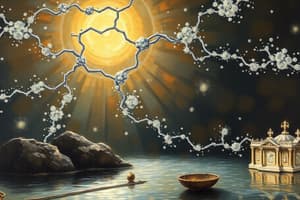Podcast
Questions and Answers
What is the primary reason atoms form bonds?
What is the primary reason atoms form bonds?
- To react with other atoms
- To gain more electrons
- To lose electrons
- To achieve a more stable electron configuration (correct)
What is the attractive force between in the formation of a bond?
What is the attractive force between in the formation of a bond?
- Between the nucleus of one atom and the electrons of another (correct)
- Between the two positively-charged nuclei
- Between the electrons of the atoms
- Between the electrons and the nucleus of the same atom
What is the purpose of a Lewis Diagram?
What is the purpose of a Lewis Diagram?
- To calculate the energy required to break a bond
- To show the arrangement of electrons in different energy levels
- To indicate the type of bond formed
- To represent the valence electrons around an atom's chemical symbol (correct)
What type of bond is formed when two pairs of electrons are shared between two atoms?
What type of bond is formed when two pairs of electrons are shared between two atoms?
What is the characteristic of a covalent bond?
What is the characteristic of a covalent bond?
What type of bond is formed when both electrons in the bond come from the same atom?
What type of bond is formed when both electrons in the bond come from the same atom?
What is the term for the electrons in the outermost energy level of an atom?
What is the term for the electrons in the outermost energy level of an atom?
What determines whether a bond will form between two atoms?
What determines whether a bond will form between two atoms?
What is the significance of noble gases in understanding chemical bonds?
What is the significance of noble gases in understanding chemical bonds?
What is the primary force responsible for the formation of a chemical bond?
What is the primary force responsible for the formation of a chemical bond?
What is the purpose of spectroscopic notation?
What is the purpose of spectroscopic notation?
What occurs when electrons in the outermost orbitals overlap in covalent bond formation?
What occurs when electrons in the outermost orbitals overlap in covalent bond formation?
What is the characteristic of a single bond?
What is the characteristic of a single bond?
What is the result of the interaction of the three primary forces between atoms?
What is the result of the interaction of the three primary forces between atoms?
What is the difference between a covalent bond and a dative covalent bond?
What is the difference between a covalent bond and a dative covalent bond?
What is the significance of valence electrons in chemical bonding?
What is the significance of valence electrons in chemical bonding?
What is the result of the interaction between the repulsive force between the electrons of the atoms and the attractive force between the nucleus of one atom and the electrons of another?
What is the result of the interaction between the repulsive force between the electrons of the atoms and the attractive force between the nucleus of one atom and the electrons of another?
What is the difference between a spectroscopic notation and a Lewis diagram?
What is the difference between a spectroscopic notation and a Lewis diagram?
What is the significance of achieving a more stable electron configuration in chemical bonding?
What is the significance of achieving a more stable electron configuration in chemical bonding?
What is the characteristic of a triple bond?
What is the characteristic of a triple bond?
What is the primary role of valence electrons in chemical bonding?
What is the primary role of valence electrons in chemical bonding?
What is the significance of noble gases in understanding chemical bonds?
What is the significance of noble gases in understanding chemical bonds?
What is the characteristic of a dative covalent bond?
What is the characteristic of a dative covalent bond?
What is the result of the overlap of electrons in the outermost orbitals in covalent bond formation?
What is the result of the overlap of electrons in the outermost orbitals in covalent bond formation?




